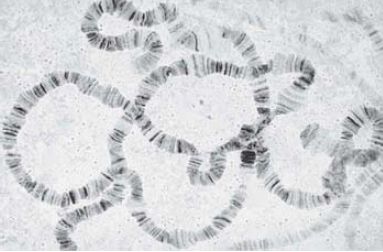


 النبات
النبات
 الحيوان
الحيوان
 الأحياء المجهرية
الأحياء المجهرية
 علم الأمراض
علم الأمراض
 التقانة الإحيائية
التقانة الإحيائية
 التقنية الحيوية المكروبية
التقنية الحيوية المكروبية
 التقنية الحياتية النانوية
التقنية الحياتية النانوية
 علم الأجنة
علم الأجنة
 الأحياء الجزيئي
الأحياء الجزيئي
 علم وظائف الأعضاء
علم وظائف الأعضاء
 الغدد
الغدد
 المضادات الحيوية
المضادات الحيوية|
Read More
Date: 21-5-2021
Date: 16-11-2020
Date: 16-6-2021
|
Polytene Chromosomes Form Bands
KEY CONCEPT
Polytene chromosomes of dipterans have a series of bands that can be used as a cytological map.
The interphase nuclei of some tissues of the larvae of dipteran flies contain chromosomes that are greatly enlarged relative to their usual condition. They possess both increased diameter and greater length. FIGURE 1 shows an example of a chromosome set from the salivary gland of D. melanogaster. The members of this set are called polytene chromosomes.

FIGURE 1 The polytene chromosomes of D. melanogaster form an alternating series of bands and interbands.
Photo courtesy of José Bonner, Indiana University.
Each member of the polytene set consists of a visible series of bands (more properly, but rarely, described as chromomeres). The bands range in size from the largest, with a breadth of approximately 0.5 μm, to the smallest, at nearly 0.05 μm. (The smallest can be distinguished only under an electron microscope.)
The bands contain most of the mass of DNA and stain intensely with appropriate reagents. The regions between them stain more lightly and are called interbands. There are about 5,000 bands in the D. melanogaster set.
The centromeres of all four chromosomes of D. melanogaster aggregate to form a chromocenter that consists largely of heterochromatin. (In the male it includes the entire Y chromosome.) The remaining 75% of the genome is organized into alternating bands and interbands in the polytene chromosomes. The length of the chromosome set is about 2,000 μm. The DNA in extended form would stretch for approximately 40,000 μm, so the packing ratio is
20. This demonstrates vividly the extension of the genetic material relative to the usual states of interphase chromatin or mitotic chromosomes.
What are the chromosomal structural features revealed by these giant chromosomes? Each is produced by the successive replications of a synapsed diploid pair of chromosomes. The replicas do not separate, but instead remain aligned with each other in their extended state. This repeated replication without sister chromatid separation is a process known as endoreduplication. At the beginning of the process, each synapsed pair has a DNA content of 2C (where C represents the DNA content of the individual chromosome). This amount then doubles up to nine times, at its maximum giving a content of 1,024C. The number of doublings is different in the various tissues of the D. melanogaster larva.
We can visualize each chromosome as a large number of parallel fibers running longitudinally that are tightly condensed in the bands and less so in the interbands. It is likely that each fiber represents a single (C) haploid chromosome. This gives rise to the name polytene (“many threads”). The degree of polyteny is the number of haploid chromosomes contained in the giant chromosome.
The banding pattern is characteristic for each strain of Drosophila. The constant number and linear arrangement of the bands were first noted in the 1930s, when it was realized that they form a cytological map of the chromosomes. Rearrangements—such as deletions, inversions, or duplications—result in alterations of the order of bands.
The linear array of bands can be equated with the linear array of genes. Thus, genetic rearrangements, as seen in a linkage map, can be correlated with structural rearrangements of the cytological map. Ultimately, a particular mutation can be located in a particular band. The total number of genic loci in D. melanogaster exceeds the number of bands, so there are probably multiple genes in most or all bands.
The positions of particular genes on the cytological map can be determined directly by the technique of in situ hybridization. The modern version of this protocol using fluorescent probes is described in the chapter titled Methods in Molecular Biology and Genetic Engineering. Although fluorescent probes are currently preferred, when the method was originally developed a radioactive probe representing the gene of interest was used; FIGURE 2 summarizes this protocol. A probe representing a gene is hybridized with the denatured DNA of the polytene chromosomes in situ, and the excess unbound probe is washed away.
Autoradiography identifies the position or positions of the corresponding genes by the superimposition of grains at a particular band or bands. (The principle is the same when fluorescent probes are used; the only fundamental difference is the detection of the label by fluorescence microscopy.) FIGURE 3 shows an example. Using in situ hybridization, it is possible to determine directly the band within which a particular sequence lies.

FIGURE 2 Individual bands containing particular genes can be identified by in situ hybridization.

FIGURE 3 A magnified view of bands 87A and 87C shows their hybridization in situ with labeled RNA extracted from heat-shocked cells.
Photo courtesy of José Bonner, Indiana University.



|
|
|
|
التوتر والسرطان.. علماء يحذرون من "صلة خطيرة"
|
|
|
|
|
|
|
مرآة السيارة: مدى دقة عكسها للصورة الصحيحة
|
|
|
|
|
|
|
نحو شراكة وطنية متكاملة.. الأمين العام للعتبة الحسينية يبحث مع وكيل وزارة الخارجية آفاق التعاون المؤسسي
|
|
|